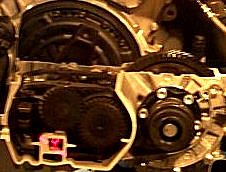|
|
Front-wheel Drive (cross-engine)
Function
This type of front-wheel drive combines good traction from the driven wheels with a compact construction method. This is a big step forward for small to moderately heavy vehicles. Additionally, they are less sensitive
to crosswinds.
How it works
The front-wheel drive with transverse mounted engine only joined the, until then, well known drive-train configurations, relatively late. In 1960 the development began, after 1970 it made its breakthrough. This was
primarily due to the construction of stable drive shaft joints. Also space-saving suspension systems had to be developed. Then however, it developed into the standard configuration, although the name is often also
used today for the front engine with rear-wheel drive.

In the above picture an open view of the transverse mounted engine is displayed. One can recognise, further behind on the left, the clutch, in front on the left, both gearbox shafts, and on the right the cut-through short
axle-drive-shaft. Behind it, in the cut-open case of the final drive, the large drive wheel is partially visible.
Disadvantages
The front-wheel drive with transverse engine shares, with the front-wheel drive with straight-mounted engine, the disadvantage
which arises from the coupling of the drive-train with the steering. In the last few years however, a great deal of work in the developing sector has been done. The strong prevalence of the
power steering has played a big part in the optimising of the driving characteristics. Sporty front-wheel drive vehicles
can hardly be distinguished from the same category with rear-wheel drive. The aerodynamics was also improved by slant-mounted engines and lower bonnets. For better crashworthiness, the engine compartments have
become larger. There are even constructions in which the engine, in the event of a frontal impact, is pushed under the passenger compartment.
Unfortunately however, the construction width is still limited. Five cylinder in-line engines are possible only in
exceptional cases. Also modern hybrid-drives with electric motors on the clutch, require more brainwork from the
designers.
Solutions for this could be:
- shorter engine construction (W form),
- triple-shaft, six-speed gearboxes,
- infinitely variable automatic gearboxes
- clutches with external release bearings.
| Axle drive with spur gears |
|
|